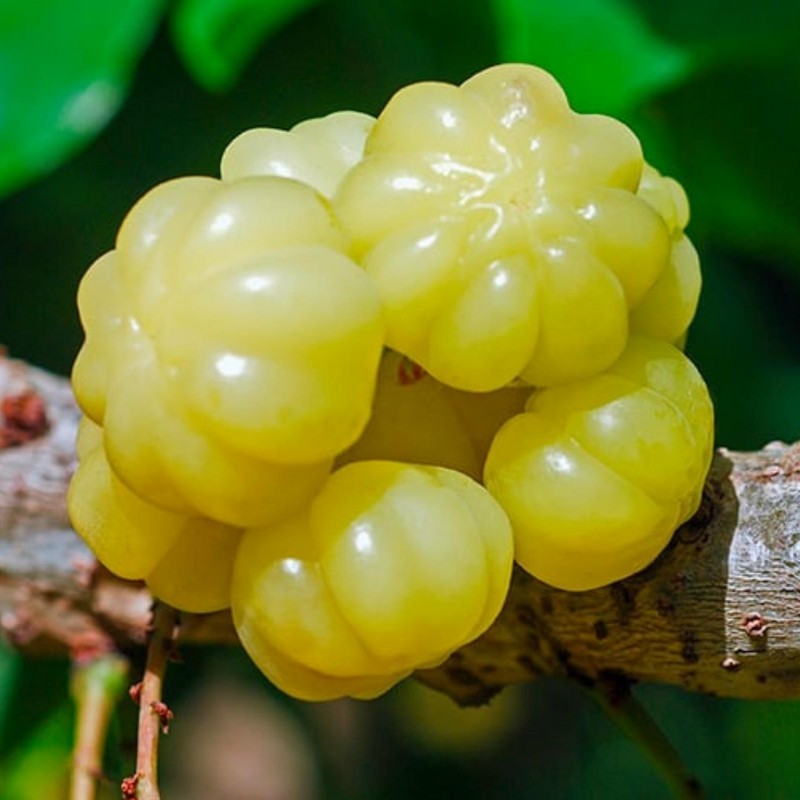
Star Gooseberry Seeds (Phyllanthus acidus)
Star Gooseberry Seeds (Phyllanthus acidus)
Price for Package of 5 seeds.
Phyllanthus acidus, known as the Otaheite gooseberry, Malay gooseberry, Tahitian gooseberry, Country gooseberry, Star gooseberry, Starberry, West India gooseberry, or simply Gooseberry tree, is one of the
Star Gooseberry Seeds (Phyllanthus acidus)
Price for Package of 5 seeds.
Phyllanthus acidus, known as the Otaheite gooseberry, Malay gooseberry, Tahitian gooseberry, Country gooseberry, Star gooseberry, Starberry, West India gooseberry, or simply Gooseberry tree, is one of the trees with edible small yellow berries fruit in the Phyllanthaceae family. Despite its name, the plant does not resemble the gooseberry, except for the acidity of its fruits. It tastes sour and tart.
Phyllanthus acidus is an intermediary between a shrub and tree, reaching 2 to 9 m (6½ to 30 ft) high. The tree's dense and bushy crown is composed of thickish, tough main branches, at the end of which are clusters of deciduous, greenish, 15-to-30-cm long branchlets. The branchlets bear alternate leaves that are ovate or lanceolate in form, with short petioles and pointed ends. The leaves are 2-7.5 cm long and thin, they are green and smooth on the upperside and blue-green on the underside. In general, the Otaheite gooseberry tree very much looks like the bilimbi tree.
The flowers can be male, female or hermaphrodite. They are small and pinkish and appear in clusters in 5-to-12.5-cm long panicles. Flowers are formed at leafless parts of the main branches, at the upper part of the tree. The fruits are numerous, oblate, with 6 to 8 ribs, and densely clustered. They are pale yellow or white, waxy, crisp and juicy, and very sour. 4 to 6 seeds are contained in a stone at the center of each fruit.
This tropical or subtropical species is found throughout Asia and also in the Caribbean region, Central and South America.
While its origin is uncertain, the species may have originated in Madagascar. It was found in other parts of South Asia early; according to Eduardo Quisumbing, it was brought to the Philippines in prehistoric times. It spread across the Indian Ocean to Réunion and Mauritius and crossed the Pacific to Hawaii. It expanded to the Caribbean in 1793, when William Bligh carried the plant from Timor to Jamaica.
The tree is common in Guam, Micronesia (where it is called ceremai or cerama), South Vietnam (called chùm ruột), Laos, northern Peninsular Malaysia (called cerme and cermai), and India (called - (Tamil-தமிழ்-[அரை நெல்லிக்காய்], chalmeri, harpharoi, [{Nellikai in kannada}], Harfi, Arunellikai, Abazhanga, Nellipuli, Usiri(Telugu-ఉసిరి), Khatamada, Arinelli, Bimbool, Arinellika, Kiru Nerle, Mara Nelli, Amla, Gihori (Manipuri), Nōṛa(Bengali-নোড়)[2][4] and rosavale (konkani language) in goa. It is still found in the Philippines (called iba in Tagalog and karmay in Ilokano), if not widely, and in Cambodia (called kantuet) and Thailand (called mayom). In Grenada, the fruit is called a damsel. In St. Lucia, the fruit is known as "see-wet". In the United States, it is found in Hawaii, and occasionally southern parts of Texas, Florida. It is also found in Puerto Rico (where the fruit is called grosella), Ecuador, El Salvador, Mexico, Colombia, Venezuela, Suriname (where it's called ronde birambi), US Virgin Islands, Peru and Brazil.
Names in other languages
அரை நெல்லிக்காய்(arainellikai, in Tamil-தமிழ்), ନରକୋଳି(narakoLi, in Odisha), Khmer: កន្ទួត (in Bangladesh) Orboroi, Grosella (in Puerto Rico), Raspberry (in Antigua and Barbuda), Jimbilin (in Jamaica), Damsel (in St Vincent and the Grenadines and Grenada), Sour Cherry (in Trinidad and Tobago), Karamay (in the Northern Philippines),Layuan (in the Bicol region of the Philippines), (Rata Nelli , Nelli Bilin in Sri lanka) Bangkiling (in the Southern Philippines), Cermai (in Brunei Darussalam, Indonesia and Malaysia), Goanbili (in Maldives), Grosella (in Belize), ဆီးျဖူသီး (in Myanmar), Guinda (in El Salvador), নোড়(Nōṛa, in West Bengal), Azedinha (in Cabo Verde), Groselha (in Brazil), มะยม [majom] (in Thailand) ,Tjerimée (in Dutch) and రాచ ఉసిరి, నక్షత్ర ఉసిరి (in Telugu)
Cultivation and human use
The Otaheite gooseberry prefers moist soil. It can be cultivated in a variety of ways—budding, cutting and air-layering—in addition to the usual seed growth. The tree is cultivated for its ornamental value, but also for food and medicinal purposes. While it produces some fruit throughout the year, it is mainly harvested in January except in South India, where it bears crops in April–May and again in August–September. As the fruit does not soften when ripe, it is harvested when the fruit begins to drop.
Various parts of the plant are used for food. In India and Indonesia, the cooked leaves are eaten. While the fruit is eaten fresh, and is sometimes used as flavoring for other dishes in Indonesia, it is generally regarded as too tart to eat by itself in its natural form and is processed further. It is candied in sugar or pickled in salt, used in chutney, relish or preserves. In the Philippines, it is used to make vinegar as well as eaten raw, soaked in salt or vinegar-salt solution and sold along the roadside. It is candied as well, usually stored in jars with syrup. They make these into a syrup in Malaysia. Liberally sugared, it is also used to make fruit juice. In Thailand it is used as an ingredient to make Som tam, to make pickled, boil in syrup (Ma-Yom Chuam).
The plant is also used medicinally. The peppered leaves are used to make a poultice to treat sciatica, lumbago and rheumatism (but have been observed to cause low blood pressure when combined with nitrates), while the seeds are used as a cathartic and the root, if prepared with care, as a purgative. The syrup is used to medicate the stomach, and in India the fruit is eaten as a blood-enhancer for the liver. P. acidus contains 4-hydroxybenzoic acid, caffeic acid,[8] adenosine, kaempferol and hypogallic acid.
While the wood is strong and durable if properly treated, the tree is not large and is rarely harvested for wood. In India, the root bark is sometimes used for tanning.
| HEIRLOOM ? | Yes |
|---|---|
| Organic Seeds ? | Organic Seeds |
| Edible ? | Edible |
| Perennial ? | Perennial plant : Yes |
| Zbierane ręcznie nasiona? | Ręcznie zbierane nasiona |
| Suitable for growing in flower pot ? | Suitable for pot: Yes |
| Plant height ? | 5-10 m |
| Origin of seeds ? | Seeds imported from: Thailand |
| Medicinal Plant ? | Medicinal Plant: Yes |


Chwilowo nie możesz polubić tej opinii
Zgłoś komentarz
Zgłoszenie wysłane
Twoje zgłoszenie nie może zostać wysłane
Napisz swoją opinię
Recenzja została wysłana
Twoja recenzja nie może być wysłana
🌍 Wysyłka na cały świat z UE
Wysyłamy zamówienia na cały świat z Unii Europejskiej za pośrednictwem poczty poleconej z potwierdzeniem odbioru.
📦 Śledzenie przesyłki
Aby śledzić przesyłkę, zaloguj się na swoje konto i przejdź do sekcji Historia zamówień > Szczegóły, gdzie znajdziesz numer śledzenia.
Śledzenie międzynarodowe: 17Track
Dla numerów takich jak RGxxxxxxHR: Śledzenie Posta.hr
🕒 Uwaga: informacje o śledzeniu pojawią się dopiero po 24 godzinach od nadania.
⚠️ Ważne uwagi
Płatność za pobraniem nie jest możliwa.
Sprawdzaj folder SPAM / Niechciane w swojej skrzynce e-mail, aby nie przegapić powiadomień.
Korzystaj wyłącznie z formularza kontaktowego na naszej stronie.
Wiadomości wysłane bezpośrednio na e-mail mogą nie zostać odebrane.
📱 Numer telefonu wymagany
Podczas składania zamówienia koniecznie podaj numer telefonu komórkowego z kodem kraju.
Przykład: +48 123 456 789
🚚 Warunki dostawy
Dla przesyłek poleconych wymagany jest podpis odbiorcy (osoby, do której adresowana jest paczka).
Nie zamawiaj, jeśli:
chcesz, aby paczka została dostarczona do skrzynki pocztowej
nie będzie Cię w domu w czasie doręczenia
chcesz, by paczka została zostawiona u sąsiada (❌ to niemożliwe)
📬 Podanie adresu skrzynki pocztowej oznacza utratę prawa do zwrotu w razie zagubienia przesyłki.
↩️ Zwrot paczki i ponowna wysyłka
Jeśli paczka zostanie zwrócona do nas z jakiegokolwiek powodu:
Pokrywasz koszt zwrotu 2 €
Oraz koszt ponownego nadania
⏱ Opóźnienia i śledzenie
Jeśli śledzenie wskazuje, że paczka wciąż jest „u nadawcy”, oznacza to, że jest w transporcie.
Skontaktuj się z lokalnym urzędem pocztowym, podając numer śledzenia.
Nie jesteśmy firmą kurierską – nie mamy możliwości monitorowania przesyłek za klientów.
Nie ponosimy odpowiedzialności za czas dostawy.
🔍 Reklamację zagubionej paczki możemy rozpocząć dopiero po 30 dniach od daty wysyłki.
✈️ Opcje wysyłki
| Typ wysyłki | Czas realizacji | Ubezpieczenie | Możliwe opóźnienie | Uwagi |
|---|---|---|---|---|
| Standardowa | 7–10 dni roboczych | ❌ | 7–14 dni | Najtańsza opcja |
| Priorytetowa | 1–7 dni roboczych | ❌ | 3–10 dni | Zamówienie przetwarzane priorytetowo, ale nie szybciej |
| Ubezpieczona | 1–7 dni roboczych | ✅ | 3–10 dni | Zwrot kosztów w przypadku zagubienia paczki (do 150 €) |
🕒 Szacowany czas dostawy:
W obrębie Unii Europejskiej: 3–20 dni roboczych
Globalnie: 5–30 dni roboczych
Przykładowe dostawy do USA: 27, 22, 19, 17, 13 dni
💳 Metody płatności
💶 Przelew bankowy (SEPA / IBAN / SWIFT-BIC)
W opisie przelewu koniecznie podaj numer zamówienia (np. SGS-19811702).
Brak opisu może spowodować opóźnienie lub anulowanie zamówienia.
Jeśli płatność nie zostanie zaksięgowana w ciągu 7 dni – zamówienie zostanie anulowane.
🅿️ PayPal
Akceptujemy płatności wyłącznie w euro.
Ustaw walutę na euro podczas płatności.
💳 Karta płatnicza
Płatności kartą odbywają się przez naszą stronę: Exotic Seeds Store
Akceptujemy: Visa, MasterCard, American Express, Diners Club, UnionPay, JCB, Discover i inne.
💡 Klient ponosi wszelkie opłaty transakcyjne.
Aby przyspieszyć realizację zamówienia, prześlij potwierdzenie przelewu.
📅 Dodatkowe uwagi
Nie przetwarzamy zamówień ani nie wysyłamy paczek w soboty i niedziele.
Przed złożeniem zamówienia sprawdź ogłoszenia na naszej stronie (np. przerwy świąteczne lub specjalne warunki).
📫 Uwaga:
Nie wysyłaj wiadomości e-mail. Używaj wyłącznie formularza kontaktowego dostępnego na naszej stronie.
Related Products



















